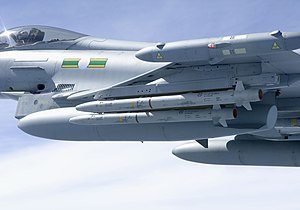| ASRAAM | |
|---|---|
 Two ASRAAM (centre) on an RAF Typhoon in 2007 | |
| Type | Short-range air-to-air missile |
| Place of origin | United Kingdom |
| Service history | |
| In service | 1998 |
| Used by | RAF, IAF |
| Production history | |
| Manufacturer | MBDA UK |
| Unit cost | >£200,000 |
| Variants | Common Anti-aircraft Modular Missile (Sea Ceptor/Sky Sabre) |
| Specifications | |
| Mass | 88 kg (194 lb) |
| Length | 2.90 m (9 ft 6 in) |
| Diameter | 166 mm (6.5 in) (motor diameter)[1] |
| Wingspan | 450 mm |
| Warhead | 10 kg (22 lb) blast/fragmentation |
Detonation mechanism | laser proximity fuze and impact |
| Engine | dual-burn, high-impulse solid rocket motor[2] |
Operational range | 25+ km[3][4][5] |
| Flight altitude | N/A |
| Maximum speed | Mach 3+[6] |
Guidance system | infrared homing, 128×128 element focal plane array, with lock-on after launch (LOAL) and strapdown inertial guidance[6] |
Launch platform | |


The Advanced Short Range Air-to-Air Missile (ASRAAM), also known by its United States designation AIM-132, is an imaging infrared homing air-to-air missile, produced by MBDA UK, that is designed for close-range combat. It is in service in the Royal Air Force (RAF), replacing the AIM-9 Sidewinder. The ASRAAM is designed to allow the pilot to fire and then turn away before the opposing aircraft can close for a shot. It flies at over Mach 3 to ranges in excess of 25 kilometres (16 mi).[3] It retains a 50 g maneuverability provided by body lift and tail control.[7][1]
The project started as a British-German collaboration in the 1980s. It was part of a wider agreement in which the US would develop the AIM-120 AMRAAM for medium-range use, while the ASRAAM would replace the Sidewinder with a design that would cover the great range disparity between the Sidewinder and the AMRAAM. Germany left the programme in 1989. The British proceeded on their own and the missile was introduced into RAF service in 1998. It is being introduced to the Indian Air Force, the Qatar Air Force and the Royal Air Force of Oman, and formerly saw service in the Royal Australian Air Force.
The ASRAAM is also the base design for the Common Anti-Aircraft Modular Missile (CAMM) used by the British Army, Royal Navy and several allied forces in the surface-launched role. A surface-launched variant of the ASRAAM itself has been improvised for the Armed Forces of Ukraine.
- ^ a b Asraam background (PDF), MBDA, archived from the original on 4 October 2013
{{citation}}: CS1 maint: bot: original URL status unknown (link). - ^ "Asraam", RAF, MoD, archived from the original on 19 February 2007, retrieved 29 May 2014.
- ^ a b "ASRAAM". MBDS Systems. Archived from the original on 10 April 2021. Retrieved 17 March 2021.
- ^ "ASRAAM". Science & Technology (documentary). jaglavaksoldier. Archived from the original on 18 June 2014. Retrieved 10 July 2009 – via YouTube.
- ^ a b "AIM-132 ASRAAM". FAS. Archived from the original on 16 March 2011. Retrieved 12 December 2011.
- ^ "Asraam", Typhoon, Star streak, archived from the original on 23 April 2012.